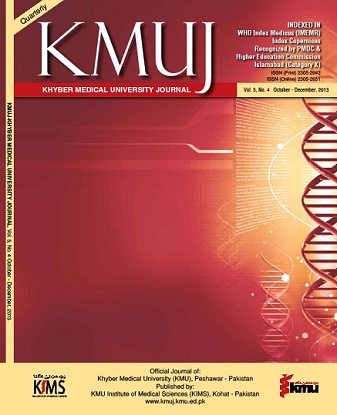SENSITIVITY PATTERN OF BACTERIAL ISOLATES IN NEONATAL SEPSIS: A HOSPITAL BASED STUDY
Main Article Content
Abstract
Objective: To determine the sensitivity pattern of bacterial isolates in neonatal sepsis at a tertiary care hospital of Peshawar.
Methodology: This cross sectional study was carried out at the department of paediatrics, Rehman medical institute Peshawar, from 1st January 2006 to 30th June 2012. Out of 4900 neonates admitted to the department of neonatology during the study period, 2256 (46.04%) neonates had clinical signs and symptoms of sepsis. Only 440/2256 (19.5%) neonates with positive blood cultures were selected for the study. All the blood cultures were done following a standard protocol.
Results: Out of 440 cases of neonatal sepsis, 309 (70.2%) were males and 131 (29.8%) were females. Mean age of patients was 8.93 ± 8.70 days. Nineteen different micro-organism were isolated in which Staphylococcus Aureus (n=282; 64.1%), Enterococcus fecalis (n=61; 13.9%), Klebsiella pneumonia (n=30; 6.8%) and Escherichia coli (n=25; 5.7%) were most common organism. Gram positive organisms were mostly sensitive to vancomycin, imepenime, ceoftaxime, amikacin and amoxacillin, while gram negative organisms were mostly sensitive to amikacin and imepenime. Overall penicillin and cephalosporin has shown high resistance to gram negative organism, while ampicillin was found to be resistant to both gram positive and gram negative organism.
Conclusion: Staphylococcus Aureus, Enterococcus Fecalis, Klebsiella pneumonia and Escherichia coli are the commonest pathogens in neonatal sepsis in our set up. In era of highly resistant micro-organism, vancomycin, amikacin, cefotaxime, and imepinime may be considered as drug of choice for empirical treatment of neonatal sepsis on the basis of highest sensitivity amongst tested drugs.
Article Details
Work published in KMUJ is licensed under a
Creative Commons Attribution 4.0 License
Authors are permitted and encouraged to post their work online (e.g., in institutional repositories or on their website) prior to and during the submission process, as it can lead to productive exchanges, as well as earlier and greater citation of published work.
(e.g., in institutional repositories or on their website) prior to and during the submission process, as it can lead to productive exchanges, as well as earlier and greater citation of published work.
References
Waheed M, Laeeq A, Maqbool S. The etiology of neonatal sepsis and patterns of antibiotic Resistance. J Coll Physicians Surg Pak 2003;13: 449–52.
Sundaram V, Kumar P, Dutta S, Mukhopadhyay K, Ray P, Gautam V, et al. Blood culture confirmed bacterial sepsis in neonates in a North Indian tertiary care center: Changes over the last decade. Jpn J Infect Dis 2009;62: 46–50.
Movahedian AH, Moniri R, Mosayebi Z. Bacterial culture of neonatal sepsis. Iranian J Publ Health 2006; 35:84–9.
Murty DS, Gyaneshwari M. Blood cultures inpaediatric patients: A study of clinical impact. Indian J Med Microbiol 2007;25 (3):220-4.
Malik-Ma, Hussain-W, Izhar-M. Ten years surveillance of bacterial isolates from blood cultures of neonates. Pak Ped J 2002; 26(3): 113-8.
Anwer SK, Mustafa S, Pariyani S, Ashraf S, Taufeeq KM. Neonatal sepsis: An etiological study. J Pak Med Assoc 2000; 50(3):91–4.
Muhammad Z, Ahmed A, Hayat U, Wazir MS, Rafiyatullah, Waqas H. Neonatal sepsis: Causative bacteria and their resistance to antibiotic. J Ayub Med Coll Abbottabad 2010; 22(4): 33-6.
Rahman S, Hameed A, Roghani MT, Ullah Z. Multidrug resistant neonatal sepsis in Peshawar, Pakistan. Arch Dis Child Fetal Neonatal Ed 2002; 87 (1): F52-4.
Ahmad A, Hussain W, Lamichhane A, Aslam M, Riaz L. Use of antibiotic in neonatal sepsis at neonatal unit of tertiary care hospital. Pak Paed J 2011; 35(1): 3-7.
Cohen ML. Changing patterns of infectious disease. Nature 2000 17;406(6797):762-7.
Shahian M, Pishva N, Kalani M. Bacterial etiology and antibiotic sensitivity patterns of early-late onset neonatal sepsis among newborns of Shiraz, Iran. Iran J Med Sci 2010; 35(4):293-8.
Stoll BJ, Weisman LE. The Global Impact of Neonatal infection: Clin Perinatol 1997;24(1):1-21.
Shah MN, Desai PB. Neonates with septic outcome: A bacteriological study. J Adv Dev Res 2012;3 (1): 88-91.
Weinberg GA, Powell KR. Laboratory aids for the diagnosis of neonatal sepsis Infectious diseases of the fetus and newborn infant. Eds, Remington JS, Kle in JO philadelphia: W. B. saunders, 200:1 5th ed. 1327-44.
Al-Bahadle, Abdul-Karem J M, Mohammad, Areege AA. The causative organism of Neonatal sepsis in al-Kadhimiyia Teaching hospital. Iraqi J Med Sci 2011;9(2):184-8.
Karthikeyan G, Premkumar K. Neonatal Sepsis: Staphylococcus Aureus as the Predominant pathogen. Indian J Pediatr 2002; 68(8): 715- 7.
Thomas M, Padmini B, Srimathi G, Sundararajan V, Rajni BA. Microbial profile of neonatal infection in coimbatore. Indian J Pediatr 2007; 66:11-4.
Refdanita, Endang P, Nurgani A, Radji M. The sensitivity pattern of microorganisms against antibiotics at the intensive care unit of Fatma Wati Hospital Jakarta. J Makara 2004;8(2): 41-8.
Iregbu KC, Olufumilayo YE, Iretiola BB. Bacterial profile of neonatal septicaemia in tertiary hospital in Nigeria. Afr Health Sci 2006; 6(3): 151-4.
Nwadioha SI , Nwokedi EOP, Kashibu E, Odimayoand MS, Okwori EE. A review of bacterial isolates in blood cultures of children with suspected septicemia in a Nigerian tertiary Hospital. Afr J Microbiol Res 2010;4(4): 222-5.
Arora U, Devi P. Bacterial profile of blood stream infections and antibiotic resistance pattern of isolates. JK Science 2007;9(4):186-9.
Mehta M, Dutta P. Gupta V. Antimicrobial susceptibility in blood infection from Teaching hospital, India, JPN. J Infec dis 2005;58(3):174-6.
Mathur NB. Neonatal sepsis. Indian Pediatr 1996;33: 663-74.
Waseem R, Khan M, Izhar TS. Neonatal sepsis. Professional Med J 2005; 12(4):451–6.
Jick S. Ciprofloxacin safety in a pediatric population. Pediatr Infect Dis J 1997;16 (1):130-4.
Karthikeyan G, Premkumar K. Neonatal sepsis: Staphylococcus aureus as the predominant pathogen. Indian J Pediatr 2001; 68 (8):715-7.
Sobhani A, Shodjai H, Javanbakht S. Drug resistance pattern in isolated bacteria from blood cultures. Acta Medica Iranica 2004;42 (1): 46-9.
